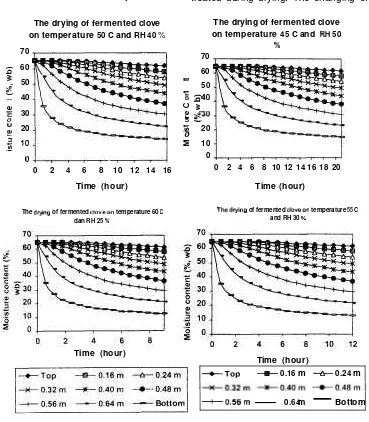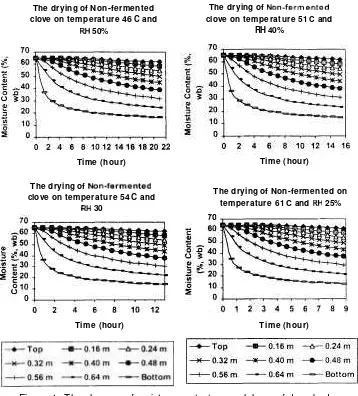Vol. 15, No. 1, April 2001
MODEL AND SIMULATION OF DEEP-BED CLOVE DRYING:
EFFECT OF FERMENTED TREATMENT
Agus Supriatna
Abstract
This paper describes the prediction of deep-bed clove drying. This model also considers mass and heat profile that was affected by fermentation process. This model used the equation of two-dimensional finite difference approximation. The dynamic of two-dimensional equation were solved numerically by alternating direction method and then applied to simulate the changes of moisture content and temperature of cloves during drying process. The capabilities of these models were compared with experimental data obtained from the research under variable conditions such as temperature and relative humidity on fermentation and treatment of cloves. The result of simulation showed that the equilibrium of moisture content (EMC) was considerably decreased whereas the rate of drying was dramatically increased with the increase of the temperature of drying. The profile of moisture content on deep-bed cloves drying was unique. The fermented and non-fermented treatments of the cloves did not give significant differences on the drying time order to achieve the equilibrium of moisture content.
Keywords
: Clove, drying, simulation, model INTRODUCTIONDrying is defined as removal of moisture from a product. Drying pro- cess plays an important role in a num- ber of industries such as agriculture, medicine and food. Henderson and Perry mentioned that the drying is the removal of moisture to a moisture content in equilibrium with normal atmospheric air or to such a moisture content that the product free from molds, enzymatic action, and insect. The drying process in agricultural products has several advantages: a)
Early harvest (at high moisture content) minimize field damage and shatter loss and facilitates tillage operations for such products, b)
period storage without product deterioration is possible, c) Viability of seeds is maintained over long periods, d) Quality of the products are better, e) Economic value of the product is greater, f) Useful product can be converted from wastes.
Drying of grain requires exposure to an atmosphere of lower relative humi- dity than the equilibrium value at the grain surface. This can be arranged by flowing a hot gas of low relative hu- midity around the grain. One of the most conventional methods of drying is the bed type. In this type of dryer, grain drying considered as batch process where moisture content, air and grain temperature, and the humi- dity of the air change simultaneously.
Other type, moving bed dryer considered that grain and drying gas flow continuously.
Mathematical model and computer of grain drying are now widely used in agricultural engineering research. Several models have been proposed to describe the heat and mass transfer processes in the types of connective grain dryer. The basic simulation approach used was to calculate the drying performed on a thin layer of grain and then combine many thin layers to the whole grain bed depth and simulate them by consecutively changes that occur during and moisture content profile by coupled transfers of heat and mass inside
a
corn grain that developed on the basis of the Luikov model. Their model considers the transfer of water by diffusion under the influence of a gradient of the moisture and by
diffusion under the influence of a temperature gradient. The temperature profiles obtained are generally flat, however distribution of the moisture content inside the grain shows large variation with time.
The objective of the research is to describe the prediction of deep-bed clove aromaticum) drying. model also considers mass and heat profile which is affected by process. This model used the equation of two-dimensional finite difference approximation.
MATERIALS AND METHOD
two kind of treatment those are (a) fermented cloves, it covered with four layer of black plastic during 40 hours, (b) non-fermented cloves. Both of the cloves were dried on several coupled of temperature and relative humidity. The equipment used was bed-dryer. The thin-layer drying of clove has been obtained using mathematical model of infinite slab (Whitaker dan Young, 1972):
- 1
Based on equation the equation of equilibrium of moisture content and drying coefficient had been obtained as follows 1987): content in each layer of deep-bed clove drying the following assumptions was used : layer which contact with atmospheric air) was equal to environmental air. There was no drop of thickness during drying caused by shrunk process.
Based on that assumption so could be derived to the differential equation of moisture equilibrium (Bird et al., 1966) :
The research was conducted in Research Institute for Spices and Medicinal Crops on June 2000. Simulation based on thin layer of clove drying and developed to deep-bed drying. Cloves were distinguished by
Vol. 15. No. 2001
approximation. The last form of finite While i = n - 1, because of = ,
difference model was: = Equilibrium of Moisture Content (Me), so that equation (9) becomes :
Fig. 1. The changes of moisture content on deep-bed clove drying.
The subscript i and indicate the time and thickness of layer. For stability re- asons, choice of At and should meet the following criteria :
Equation (10) could be formed into three-diagonal matrices, and then it could predict the changes of moisture content in each layer of deep-bed drying on a certain of time.
A t ) = 2
RESULTS AND DISCUSSION For i = 1 so that ,+, =
,
initialmoisture content (Ma), and equation (7) becomes
The difference of T (wb) and
A. Equilibrium of Moisture Content and Drying Coefficient
The changes of equilibrium of moisture content and drying coefficient on clove drying are given in Figure 2.
Temperature, T (wb)
Fig. 2. The Equilibrium of Moisture Content (a) and Drying Coefficient (b) on each temperature changing of thin layer clove drying.
36
In Figure 2 (a), we can see that the graph of the equilibrium of moisture content was considerably decrease proportionally with increasing of the difference of wet -bulb temperature and dry-bulb temperature. The graph of non-fermented clove was higher than fermented clove. It was caused by the treatment of fermentation. On fermented clove, it has occurred the decreasing of moisture content before the drying process. The drying coefficient was dramatically increase
proportionally with the increasing of drying temperature. It indicated that the rate of evaporation of the product was 'higher proportionally with the increasing of drying temperature.
The deep-bed clove drying
On the deep-bed clove drying, the product was supposed as a number of a thin-layer drying. The variation of drying temperature and relative humidity in the plenum chamber was treated during drying. The changing of
The drying of fermented clove The drying of fermented clove on temperature 50 C and RH40 % on temperature 45 C and 50
70
70
60 60
50 50
40
30
0
20 20
0
10 0
0 2 4 6 8 10 12 14 16 0 2 4 6 8 10 12 14 16 18 20
Time (hour) Time (hour)
The of fermented temperature 60 of fermented temperature 55 C
dan RH 25 and RH 30
Time (hour)
Time (hour)
0.16 m 0.24 m
- 0.64 m
-
BottomVol. 15, No. 1, April 2001 moisture content on each layer are
given in Figure 3 and 4.
From the graph (Fig. 3) we can see that the decreasing profile of moisture content on deep-bed clove was specific during drying process. On the each treatment, the higher temperature and the lower relative humidity led to achieve the equilibrium of moisture content on the bottom layer more rapid.
Figure 4 shows predictions of changes moisture content on fermented cloves during drying process. The moisture content of grain
The drying of Non-fermented clove on temperature 46 C and
50%
Time (hour)
The drying of
clove on temperature 54 C and 30
is decreasing during removal of the moisture. The removal of moisture is dramatically decrease in the initial periods on the bottom layer, and slightly decrease in the end of drying periods.
For both treatment, the drying process will be faster when drying temperature was high and relative humidity was low. The difference of both treatment was not significant to the rate of drying. This condition as shown in Figure 3 and 4.
The drying of
clove on temperature 51 C and RH 40%
Time (hour)
The drying of Non-fermented on temperature 61 C and 25%
Time (hour) Time (hour)
CONCLUSIONS
The mathematical drying models developed and presented in this paper can be used to predict the performance of deep-bed grain drying. The predicted results as determined by these mathematical models permit analysis of dispersion effect for heat and moisture in the bed.
REFERENCES
M., R. Gilbert and C. Laguerie. 1990. An Experimental and Theoretical Analysis of Mechanism of Heat and Mass Transfer During The Drying of Corn Grain in Fluidized Bed. Chem. Eng.,
C. Model Matematik
Pengeringan
Cengkeh. Faculty of Agricultural Engineering and Technology, Agriculture University, pp 12-35. Bird, R.B., Stewart and E.N.
Lightfoot 1960. Transport Phenomena. John and Son, New York.
Courtois, F . 1997. Dynamic Modeling of Drying to Improve Processing
Quality of Corn.
Henderson, S.M. and R.L. Perry. 1976.
Agricultural Process Engineering. The AVI Publishing Co. Westpor! Connecticut. pp 180-200. Thompson, T.L. Simulation for
Optimal Grain Dryer Design. ASAE Annual Meeting, Paper No. 68-439.
1-17.


